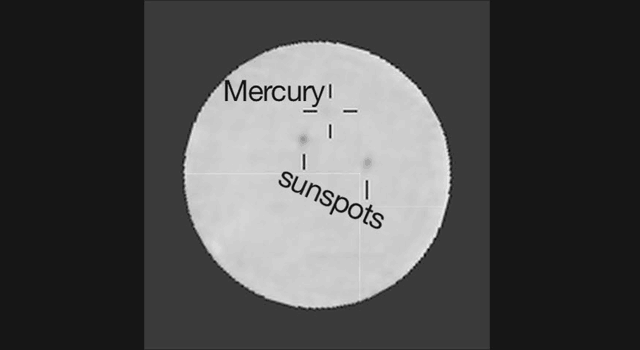Mercury Passes in Front of the Sun, as Seen From Mars
http://www.jpl.nasa.gov/news/news.php?release=2014-183
http://www.jpl.nasa.gov/spaceimages/details.php?id=PIA18389
http://www.jpl.nasa.gov/video/?id=1309 => Video
This animated blink comparison shows five different versions of observations that NASA's Curiosity made about one hour apart while Mercury was passing in front of the sun on June 3, 2014. This animated blink comparison shows five versions of observations that NASA's Curiosity made about one hour apart while Mercury was passing in front of the sun on June 3, 2014. Two sunspots, each about the diameter of Earth, also appear, moving much less than Mercury during the hour.
June 10, 2014
NASA's Curiosity Mars rover has imaged the planet Mercury passing in front of the sun, visible as a faint darkening that moves across the face of the sun.
This is the first transit of the sun by a planet observed from any planet other than Earth, and also the first imaging of Mercury from Mars. Mercury fills only about one-sixth of one pixel as seen from such great distance, so the darkening does not have a distinct shape, but its position follows Mercury's expected path based on orbital calculations.
The observation by the telephoto camera of Curiosity's two-eyed Mast Camera instrument is available online at:
http://www.jpl.nasa.gov/video/?id=1309
"This is a nod to the relevance of planetary transits to the history of astronomy on Earth," said Mark Lemmon of Texas A&M University, College Station, a member of the Mastcan science team. "Observations of Venus transits were used to measure the size of the solar system, and Mercury transits were used to measure the size of the sun."
The observations were made on June 3, 2014, from Curiosity's position inside Gale Crater on Mars. In addition to showing the Mercury transit, the same Mastcam frames show two sunspots approximately the size of Earth. The sunspots move only at the pace of the sun's rotation, much slower than the movement of Mercury.
Many viewers on Earth observed a Venus transit in June 2012, the last visible from Earth this century. The next Mercury transit visible from Earth will be May 9, 2016. Mercury and Venus transits are visible more often from Mars than from Earth, and Mars also offers a vantage point for seeing Earth transits. The next of each type visible from Mars will be Mercury in April 2015, Venus in August 2030 and Earth in November 2084.
NASA's Mars Science Laboratory Project is using Curiosity to assess ancient habitable environments and major changes in Martian environmental conditions. NASA's Jet Propulsion Laboratory, a division of the California Institute of Technology, Pasadena, built the rover and manages the project for NASA's Science Mission Directorate in Washington.
For more information about Curiosity, visit http://www.nasa.gov/msl and http://mars.jpl.nasa.gov/msl/. You can follow the mission on Facebook at http://www.facebook.com/marscuriosity and on Twitter at https://twitter.com/marscuriosity.
Guy Webster
Jet Propulsion Laboratory, Pasadena, Calif.
818-354-6278
[email protected]
2014-183




